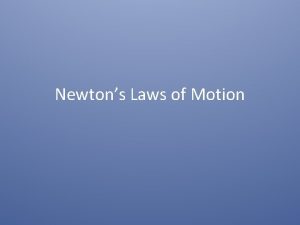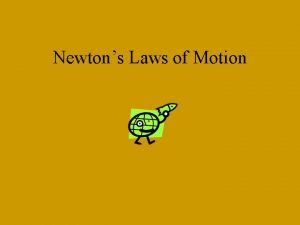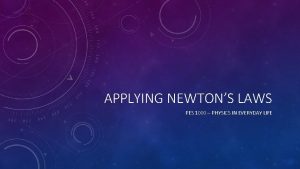NEWTONS LAWS OF MOTION PES 1000 PHYSICS IN







- Slides: 7

NEWTON’S LAWS OF MOTION PES 1000 – PHYSICS IN EVERYDAY LIFE

HISTORY OF THE LAWS OF MOTION • Aristotle (384 -322 BC) believed that the natural state of an object was rest, and that all objects sought this state. For an object to have motion (velocity) a force must continually act on it. • He was unaware of forces such as fluid drag and friction. • Galileo Galilei (1564 -1642 AD) realized that the natural state of an object is constant velocity (constant speed and direction), and that forces were required to change this state. • Galileo also discovered that all object fall at the same rate if drag is ignored. • He also understood the property of matter that we call inertia. • Isaac Newton (1642 -1726) put Galileo’s discoveries together to form a complete set of three laws to explain motion.

NEWTON’S FIRST LAW OF MOTION • This is sometimes called the Law of Inertia • Newton stated that “An object at rest will remain at rest unless acted upon by a net force. An object in motion will remain in motion with constant speed and constant direction unless acted upon by a net force. ” • ‘Net force’ is another way of saying ‘the sum of all the forces’. • Alternative statements: • Inertia resists changes in velocity (what we call acceleration). • The natural state of an object is constant velocity. Force is required to change this state. • Consequences of the law: • If no forces act on an object (e. g. it is moving through space), it will continue forever in the same direction without expending any effort (fuel). • If an object does come to rest after moving, then there must have been forces acting on it, like drag or friction.

NEWTON’S SECOND LAW OF MOTION •

NEWTON’S THIRD LAW OF MOTION • This is sometimes called the Law of Action and Reaction • The previous laws apply to a single object. This law applies to interactions between objects. • Newton stated that “For every action, there is an equal but opposite reaction. ” • ‘Action’ was Newton’s word for what we call ‘force’. • Alternative statement: • If one object pushes on another, the second object resists by pushing back against the first. • Consequences of the law: • Forces between objects (‘internal to the system’) cancel each other out (otherwise the objects would move apart!), but the system can have external forces on it, causing it to move.

NEWTON’S LAWS APPLIED TO EXAMPLES • Law I: Rocket in space • Force must be applied to the rocket to start it moving away from Earth. • No force is needed while it travels toward the moon. • Force must be applied to stop the rocket at the moon. • Law II: Car • In order for a car to accelerate down the road it must have a net force acting on it. • The force of friction between the drive tires and the road must be greater than the drag and other forces opposing the car’s acceleration. • Law III: Train engine and cars • The forward force of the engine against the ground is more than the opposing forces, so the engine and the cars accelerate forward. • The forward internal force of the engine on the cars is equal but opposite to the inertial resistance force of the cars on the engine.

CONCLUSION • Newton’s three Laws of Motion are sufficient to explain all of the motion we see in everyday life • Law of Inertia • An object at rest will remain at rest unless acted upon by a net force. An object in motion will remain in motion with constant speed and constant direction unless acted upon by a net force. • Law of Acceleration • If an unbalanced force acts on an object, it will accelerate in the direction of the force, proportional to the force, and inversely proportional to the mass. • Law of Action and Reaction • For every action, there is an equal but opposite reaction.













